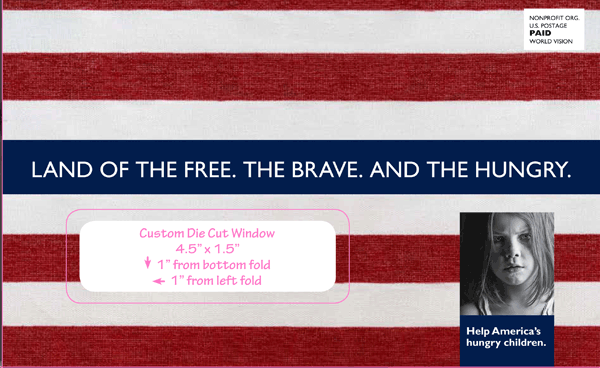World Vision Steps Up U.S. Mailings
 Christian humanitarian organization World Vision is stepping up its direct mail donor and acquisition efforts in the United States.
Christian humanitarian organization World Vision is stepping up its direct mail donor and acquisition efforts in the United States.
The mailings—sent to the house donor and prospect file as well as names from other nonprofit lists—promote a family food kit, a package of meals to feed a family of five. The kits contains oatmeal, lentil soup, pasta and a rice and bean casserole.
"We invested in a larger acquisition effort around our family food kits in the fall and then we've been doing about an appeal every other month," says Carrie Swanson, marketing channel manager of U.S. programs. "We've been very encouraged by these numbers and our donors' response to our fundraising efforts for U.S. work."
So far this year, the charity has received a 5% response rate to a mailing it sent out in February to 65,000 prospects and donors, raising more $33,000 in less than a month.
This follows a 400,000 piece mailing it sent out in October to prospects and 14,000 existing donors that yielded response rates of 6.46% and donations of $33,000, says Swanson.
The mailing's creative features the tagline "The Land of the Free. The Brave. The Hungry." on the outer envelope.
"We've fed children around the word," the copy continues, noting it cost $16 to feed a family of 5 for a day. "Now we need your help to feed them at home."
World Vision plans to integrate email into this campaign in the future. The Seattle-based organization sends emails every month to about 800,000 opt-in subscribers such as donors, volunteers, and attendees to events like speeches or an AIDS traveling exhibit.
"In email, we are often asking our users to engage with us through volunteering, advocacy, social networking, peer–to-peer fundraising or prayer, or, simply thanking them for their continued support and providing updates," says Swanson. "Email allows nonprofits to cost-effectively provide value to its donors through greater overall engagement with our work."
In the past, World Vision has used email to raise funds quickly in response to international events. Seven years ago, in the wake of the tsunami in Asia and Africa, it raised about $8 million in the U.S. and about $40 million worldwide.
World Vision does a limited amount of fundraising through social media channels like Facebook, Twitter and YouTube.
"We primarily use them to inform, equip, excite and encourage our supporters' efforts to tackle the root causes of poverty in Christ's name, help them understand how World Vision works and teach them about the humanitarian industry," Swanson says. "We're always looking for ways to get more help to children, including through social media. As we learn more about how our donors interact with us through social media, we expect to continuously improve how we leverage the medium for fundraising."

























